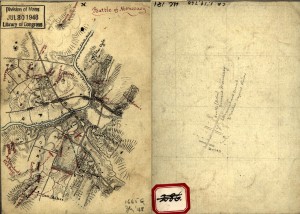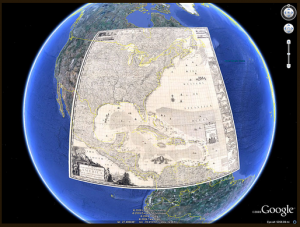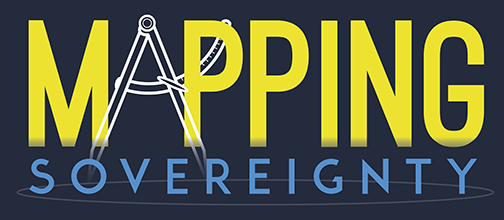Digital humanities is an evolving discipline. Pioneer researchers like Susan Schreibman, Ray Siemans and John Unsworth, describe an early perception of the discipline as “humanities computing,” in which subjects like art, literature, and history, intersect with computation of large amounts of data, revealing patterns, connections and silences. This positioned digital humanities as tool for research, like the Library of Congress’s Hotchkiss Map Collection Google Earth Project, which gives researchers a visual tool for accessing library collections. More recently, scholars such as Leighton Evans and Sian Rees, have stated that digital humanities is an integration of text and technology, which generates a new environment for research, curation, and display. This second wave of digital humanities, uses technology and data as foundations and representations of humanities research.

The projects housed on this site come from the second wave of digital humanities. They are more than visual term papers or graphical explorations of ideas because they were created, researched, and completed in digital environments. While each fits within the discourse of their particular regions, both in colonial America and the South Seas, they also speak to the larger digital humanities discipline. Digital projects like these open new avenues for continued research, exploration, and critique, without the confines of linear organization. This section discusses the project methods and the possibilities for evaluation within the discipline.
Methods
Every research project, whether in the hard sciences or humanities, begins with a question. This project began by asking “how do charters express and modify conceptions of British sovereignty in claims of overseas territory?” The team was curious about how sovereignty existed in unfamiliar landscapes and about what challenges emerged from that unfamiliarity. The projects relied on colonial charters for geographic data, like latitude, longitude, rivers, and place names, and historical data, such as names and intentions. Using the he Avalon Law Database as a dataset, the sources began as digitized texts that the team parsed and dissected. They reviewed many charters, experimenting with the creation of a large, searchable database. But because of the magnitude of sources, they narrowed the dataset to five charters,which they could deeply analyze and map.
The digital environment allowed the team to replicate some of the questions that the charters’ grantees may have encountered. Because they contained little numerical or quantifiable data, aside from rough latitudinal and longitudinal coordinates, it was difficult to concretely map the charters’ boundaries. This lack of data eliminated GIS (Geographic Information System) technology as a tool for processing and display of the data, unlike the Newberry Library’s Historical County Atlas, which utilized this platform. Alternatively, Google Earth allowed for the manipulation of the latitudinal and longitudinal data available. Google Earth was the total package for this project because it supported geographic visualization and secondary analysis and interpretation.
The team’s research about the charters and interpretation of the digital maps in Google Earth set the project apart from others, like the aforementioned Hotchkiss collection and Historical County Atlas. Because the team told the narratives of the boundaries and conflicts in colonial society, they drew conclusions about how humans interpreted the texts and shaped the landscape. The nature of the digital environment for the sources and display generated these conclusions and uniquely used current technology to do more than display history.
Evaluation

Google Earth as a platform is inexpensive and relatively easy to use, which inspires many digital humanities mapping projects. Examples include large funded projects, like the David Rumsey Collection Historical Maps and the National Library of Scotland’s map viewer and smaller independent projects like those found on this site. As the discipline grows more popular, there is a vital need for ways to evaluate projects to fit in the wider literature. Ruth Mostern, a professor of history at the University of California at Merced, is one voice seeking evaluation and pedagogy. She stated that those in the field “too often rejoice in its mere existence.” In her article “Traveling the Silk Road on a Virtual Globe: Pedagogy, Technology, and Evaluation for Spatial History,” for Digital Humanities Quarterly, Mostern argues that there are four valuable measures to what extent a digital mapping or “spatial history” project adds to the discipline. In her opinion, digital mapping for historical analysis should accomplish four tasks:
1. Spatial history should demonstrate how landscapes are created by human action.
2. Spatial history should include relationships between places and movement of people.
3. Spatial history should account for structure of populations and settlements.
4. Spatial history must be able to display multiple scales into historical analysis.
Mostern’s points are a start towards a more extensive evaluative process, but her analysis must also consider the projects at an individual level. Her points focus on spatial history, which is vital to a digital mapping project; however, in order for her argument to reach and establish standards for similar projects, it must also consider the original question, for example, “how do charters express and modify conceptions of British sovereignty in claims of overseas territory?” Digital humanities projects touch a vast subject matter, from Google’s Lit Trips to the West Philadelphia Digital Atlas, and an evaluative process must adapt to the project or else the questions are not important. Below are short evaluations of the projects on this sight that consider both Mostern’s starting points and the subject of sovereignty in unknown territories.
Connecticut
The Connecticut project argues that charters of the area were authoritative in establishing claims, but that authority also caused disputes. Through the timeline, team members displayed the changing boundaries that created clashes of sovereignty. The project is a direct example of Mostern’s first guideline for evaluation, demonstrating how landscapes, in this case borders, are created by human action. The project demonstrates that sovereignty was not not clear, even if the charter presented a straightforward conception. To expand more, the next step for the project would be to draw more from the surrounding territories to establish a fuller understanding of how the interacting narratives in Connecticut contributed to the colonial development of New England.
Georgia
The Georgia Project demonstrates a clear narrative of the development of colony. Georgia was a buffer zone between Spanish Florida and the English colonies. The borders implicated military clashes of control and interactions between British, Spanish, French, and Native Americans populations. The structure of the settlement as a buffer is a reason that these clashed occurred, returning to Mostern’s third point. The project tells the story clearly and interactively, which contributes to a better understanding of the involved parties that contributed to the ambiguity of British sovereignty beside other powers and native populations. To push the project a bit further, there is still room for growth in the explicit conclusions that can be drawn.
Maine
The Maine project is an interesting contrast to the other projects on the site because it considers a very small piece of land, as opposed to the large grants of entire colonies. While charter with large grants attempted to claim more territory for the crown, smaller grants like Maine promoted sovereignty through long term settlement. This conclusions harkens back to Mostern’s second point, while incorporating the question.
Newfoundland
The Newfoundland Project is an example of changing sovereignty within the British Empire. Royal, corporate, and proprietary claims all affected the territory’s landscape between 1600 and 1630.These claims reflected multiple scales, display through British and French mapping styles. Each royal claim projected the area in terms of the reason for being there, for example, the British drew maps of Newfoundland much differently than what is now projected in Google Earth because it projected better access to fishing resources. By graphically representing the ambiguities in the English Royal charter, it is clear why different scales of mapping were important to British conceptions of sovereignty.
South Sea Company
While the South Seas Company project did not support a final digital product, Google Earth was a tool that contributed to the project’s conclusions. By asking questions about how and what actually defined the “South Seas” in the charter, they questioned the geographic implications of omission. These omissions further reflected the ambiguity and fluidity of sovereignty that has been a continuous conclusion of the overall project. It is important to analyze why the South Seas team found difficulty in graphically displaying their project in Google Earth because it leads to questions of what those interacting with charter imagined the charter to represent on the ground. No digital project exists to compare with Mostern’s evaluative points, but the project adds to the discourse of digital humanities and spatial history by establishing and overcoming these limits.
The projects featured on this site interpret history digitally, from start to finish. Rather than serving as a tool for researchers seeking to answer questions, the team asked and answered its own questions. These projects add to the continuing exploration of technology as a means for doing history, but they also contribute to a developing conversation surrounding the evaluation of digital humanities projects. Moving forward, it will important to build the digital humanities discipline on critique to develop it within the academic field.
Further Reading
Berry, David M. Understanding Digital Humanities. Gordonsville, VA, Palgrave Macmillan, 2012.
Bodenhamer , David J. “Beyond GIS: Geospatial Technologies and the Future of History,” in Alexander von Lunen and Charles Travis ed. History and GIS: Epistemologies, Considerations and Reflections, (New York: Springer, 2013)
Bonnell, Jennifer and Fortin, Marcel, Historical GIS Research in Canada, (Calgary, AB: University of Calgary, 2014)
Boonstra, Onno. “The Dawn of a Golden Age? Historcial GIS and the History of Choropleth Mapping in the Netherland,” in Alexander von Lunen and Charles Travis ed. History and GIS: Epistemologies, Considerations and Reflections, (New York: Springer, 2013)
Borgman, Christine L. “The Digital Future is Now: A Call to Action for the Humanities, Digital Humanities Quarterly, 4 (2009)
Cohen, Daniel J and Tom Scheinfeldt (eds.). Hacking the Academy: New Approaches to SCholarship and Teaching from Digital Humanities. Ann Arbor, University of Michigan Press, 2013.
Elliot, Tom and Gillies, Sean. “Digital Geography and Classics,” Digital Humanities Quarterly, 1 (2009), https://digitalhumanities.org:8080/dhq/vol/3/1/000031/000031.html
Gregory, Ian N, and Geddes, Alistair. Toward Spatial Humanities: Historical GIS and Spatial History, (Bloomington, IN: Indiana University Press, 2014)
Gregory, Ian, and Ell, Paul S. Historical GIS: technologies, methodologies and scholarship, (New York: Cambridge University Press, 2007).
Griffiths, Sam. “GIS and Research Into Historical “Spaces of Practice”: Overcoming the Epistemological Barriers,” in Alexander von Lunen and Charles Travis ed. History and GIS: Epistemologies, Considerations and Reflections, (New York: Springer, 2013)
Lynch, Clifford. “Digital Collections, Digital Libraries and the Digitization of Cultural Heritage Information,” First Monday: Peer-Reviewed Journal on the Internet, 5-6 (2002). https://firstmonday.org/ojs/index.php/fm/article/view/949/870
Massey, Doreen. For Space, London: SAGE, 2005.
Mostern, Ruth and Gainor, Elana. “Traveling the silk Road on a Virtual Globe: Pedagogy, Technoloy and Evaluation for Spatial History. Humanities, Digital Humanities Quarterly, 2 (2013) https://digitalhumanities.org:8080/dhq/vol/7/2/000116/000116.html
Mares, Detlev. “Place in Time: GIS and the Spatial Imagination in Teaching History,” in Alexander von Lunen and Charles Travis ed. History and GIS: Epistemologies, Considerations and Reflections, (New York: Springer, 2013)
Mostern, Ruth. “Putting the World in World History.” Journal of the Association of History and Computing, 1 (2010). https://quod.lib.umich.edu/cgi/t/text/text-idx?c=jahc;view=text;rgn=main;idno=3310410.0013.103
Schreibman, Susan, Ray Siemens and John Unsworth (eds). A Companion to Digital Humanities. Blackwell Publishing, 2004
Sewell, David. “It’s For Sale, So It Muse Be Finished: Digital Projects in the Scholarly Publishing World,” Digital Humanities Quarterly, 2 (2009)
Taylor, Faye.“Mapping Miracles: Early Medieval Hagiography and the Potential of GIS,” in Alexander von Lunen and Charles Travis ed. History and GIS: Epistemologies, Considerations and Reflections, (New York: Springer, 2013)
